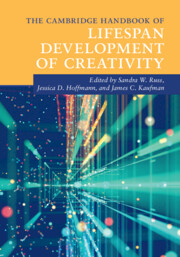Book contents
- The Cambridge Handbook of Lifespan Development of Creativity
- The Cambridge Handbook of Lifespan Development of Creativity
- Copyright page
- Dedication
- Contents
- Figures
- Tables
- Contributors
- Acknowledgments
- Introduction
- Part I Core Concepts of Lifespan Creativity Development
- Part II The Development of Creativity
- Part III Modes of Enhancement
- 12 Domain-Specific Talent Development
- 13 Enhancement of Creativity across the Lifespan in Mainland China
- 14 Beyond Flights of Fancy?
- 15 Creating Imaginary Worlds across the Lifespan
- 16 Imaginative Creativity in the Writing and Reading of Stories
- 17 The Effects of Video Games on Creativity
- Part IV Environments and Contexts
- Part V Special Populations
- Index
- References
13 - Enhancement of Creativity across the Lifespan in Mainland China
Theoretical Inquiries and Practical Examples in the New Millennium
from Part III - Modes of Enhancement
Published online by Cambridge University Press: 19 November 2021
- The Cambridge Handbook of Lifespan Development of Creativity
- The Cambridge Handbook of Lifespan Development of Creativity
- Copyright page
- Dedication
- Contents
- Figures
- Tables
- Contributors
- Acknowledgments
- Introduction
- Part I Core Concepts of Lifespan Creativity Development
- Part II The Development of Creativity
- Part III Modes of Enhancement
- 12 Domain-Specific Talent Development
- 13 Enhancement of Creativity across the Lifespan in Mainland China
- 14 Beyond Flights of Fancy?
- 15 Creating Imaginary Worlds across the Lifespan
- 16 Imaginative Creativity in the Writing and Reading of Stories
- 17 The Effects of Video Games on Creativity
- Part IV Environments and Contexts
- Part V Special Populations
- Index
- References
Summary
Research on creativity by Chinese researchers began to boom in the 1990s. From then on, creativity research and practice regarding the enhancement of creativity in Chinese societies, particularly in Mainland China, have developed very quickly. The present chapter gives an overview of the enhancement of creativity across the lifespan in Mainland China, focusing on the literature published in the new millennium. Major approaches of creativity enhancement proposed by Chinese researchers on the basis of decades of creativity research and education experience in Mainland China will be introduced. Typical examples of creativity enhancement measures for different age phases, ranging from kindergarten to later life, will be presented. Based on the review, characteristics of the research and practice on creativity enhancement across the lifespan will be summarized, and it is pointed out that more “bottom-up” approaches should be encouraged and promoted in Mainland China in its further efforts in enhancing creativity among people of different ages.
Keywords
- Type
- Chapter
- Information
- The Cambridge Handbook of Lifespan Development of Creativity , pp. 278 - 304Publisher: Cambridge University PressPrint publication year: 2021



